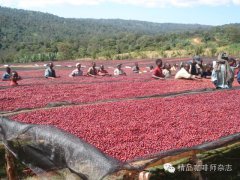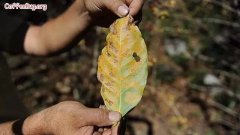How much does a cup of coffee cost? SCCAA told you
Preface to berries
It is said that domestic cafes kill people, coffee is not worth the money, read the following article, you will understand. Huaxia is reluctant to match this article with illustrations, because such practical articles, illustrations are superfluous.
Coffee, a fast-consuming product in the western world, has the same status as tea in the hearts of the Chinese, and is simply a necessity of life. In the United States, coffee imports totaled $5.5 billion in 2014, with a market value of $19 billion, with a coffee population of 161 million and coffee practitioners of 1.5 million. Maria Hill, the SCAA royal writer, will analyze the cost of American coffee for you, and we Chinese can also learn from it.
After reading this article, Berry felt that coffee culture, like other food cultures, knows no national boundaries and is worthy of respect. If the coffee culture develops and grows in China, the coffee population must increase, and the main way to increase the coffee population is to infiltrate the coffee culture into the Chinese food culture for a long time. We need domestic coffee practitioners and enthusiasts to clearly have a sense of mission and unite to spread the real coffee culture. Only in this way can the coffee population growth cycle be shortened and China's coffee industry develop.
Once again, the cost and price of raw beans and roasted coffee quoted in the following article are American prices, in order to let readers understand the cost of coffee from seed to a cup of coffee.
The unit price of coffee varies according to different types of coffee, different producing areas, different auction scores, different capacity of coffee consuming countries, and so on. For example, all intellectual items and Italian styles are sold in the berry store, and the cost of each bag of beans (345g), including tax and freight, is about 410 yuan. But it does not include 200000 a year's rent, 2000 monthly water and electricity, 20, 000 a year for property, 10, 000 a year for public damage, not to mention labor costs for Lingling and Huaxia. In addition, the customs has to pierce at least two bags of beans for every 10 bags (the two bags taste like oil and can't drink at all), and if the berries are still indigestible after a month of baking, the berries have to be thrown away.
"translated text"
"The Cost of a Cup of Coffee: Where Does the Money go?"
Author: Maria Hill-SCAA chief planner, royal writer
Original address: http://www.scaa.org/chronicle/2014/09/15/the-cost-of-a-cup-of-coffee-where-does-the-money-go-2/
In the past few years, the boutique coffee market has experienced a process of fluctuation, and the price of coffee market is slightly higher than before. Due to the increase in the cost of coffee production, the price of finished coffee has risen.
The coffee price tags of the world's major coffee chains have also been revised. For consumers, the rise in the price of coffee baffles their second monk. On the coffee futures market, the price of raw coffee beans is $1.75 per pound (345 grams). But when consumers go to their favorite coffee roaster to buy roasted beans, they pay $9 per pound for $9, 000, and it's pre-tax. So how is this account calculated?
According to Ric Rhinehart, executive director of SCAA, the price difference of a cup of coffee depends not only on the apparent difference between raw and cooked beans, but also on many other factors.
The cost of a cup of coffee should be calculated from the day you step out of the production estate. Typical sources of fees include labor, fertilizers, inspections, certification (organic certification, rainforest alliance, fair trade certification), transportation, and some membership fees (if the manufacturer cooperates with SCAA). Although some production costs are easily identified and recorded during coffee production, the costs vary depending on the size of the farm, the location, and the farmer. So figuring out the cost of a pound of raw beans is challenging. In particular, fine coffee, different producing areas, different labor quality, different climatic conditions, and so on, will add to the cost.
The coffee berries are picked, processed, picked up by the exporter in accordance with the contract, shipped to the importer in the consuming country, and then poured into the roaster in the third wave of boutique cafes. The roaster (in this case, the third wave of boutique cafes in the United States with roasters) is solely responsible for and calculates the actual cost of the beans, such as negotiating the price per pound with the contract holder, as well as any additional charges, including import / export transportation. In the actual roasting process, as the water in the raw coffee beans evaporates at high temperature, the roasted beans are reduced by 18%, that is, after 1 pound of raw beans are roasted, only 0.82 pounds of roasted beans are left.
Let's calculate the cost now: for example, a baker buys a pound of raw coffee beans worth $2.25, and after roasting, the weight is reduced by 18%, and the adjusted price of the same pound of coffee is $2.75.
Anyone who has studied ACCA knows General Operating Expense (general operating expenses), which in this case refers to labor, expenses, and packaging costs. Combined, the cost of the last pound of baked beans is $6.50. The roaster needs to make a profit when the pound of coffee is sold to other cafes, so the final price to be sold to the cafe will be around $7.50 per pound.
The barista baked the coffee beans and arrived at the cafe. The cafe is the last stop in the cost analysis chain.
The director of Rhinehart once pointed out: "one thing that even coffee farmers know is that in American cafes, a cup of coffee costs $3.50, while a pound of beans (345g) can make 50 cups of coffee, so in theory, a bag of beans can create a turnover of $175m. But coffee farmers only know that they get only $2.25 per pound of raw beans.
If we look carefully, there are still some things that do not count. In fact, a pound of coffee beans can not produce 50 cups at all! Because according to the SCAA gold cup standard, 3.75 ounces (106g ~ 113g) of coffee beans can only brew 64 ounces (1814 grams) of coffee solution, that is, the SCAA golden cup standard water powder ratio is 1:16 or 1:17. However, the coffee solution that consumers order in a coffee shop is generally 16 ounces (454 grams) of coffee. This means that a pound of coffee beans can only produce 15 to 17 cups of coffee. For example, if a coffee shop sells a 16-ounce cup of coffee for $1.95, the total sales of a pound of coffee beans is about $30. Even if the cafe can still make a profit of $20 on this pound of beans, don't ignore fixed costs (Fix Cost) such as rent, labor, utilities, and other daily expenses.
Well, seeing here, you should have an idea of the cost of coffee. That is, the total cost of the whole process from a seed to a cup of coffee, then we also need to find the problems in this system.
In the current coffee pricing system, coffee farmers do not have the right to price their carefully cultivated boutique coffee, and this is completely incorrect! Coffee farmers no longer believe in the bullshit of "a little hard work, a little harvest" because they know that only London and New York futures markets can price their coffee. The director of Rhienhart once pointed out: "Coffee futures market abbreviates coffee to small" c ". In other words, those stupid financiers always subjectively define everything as "as black as a crow in the world", coffee is coffee, and the direct victim of this theory is the farmers of fine coffee. If the baker suddenly raises the wholesale price, the cafe can choose whether or not to increase the retail price on the menu. If the baker is told by the importer that the price of raw beans has increased recently, the baker can also selectively adjust the wholesale price. But! If the cost of growing coffee increases, coffee farmers have no choice, because the price of raw beans is the market average price (Average Market Price) determined by the futures market. This is so unfair.
On the other hand, it's a good thing that bakers don't see Coffee as a "small c" like financiers, and consumers who like boutique coffee are not as black as crows in the world as financiers think. Boutique coffee accounts for less than 30% of the world's coffee, the price of most boutique coffee is still acceptable, boutique coffee in the boutique is becoming more and more scarce and expensive. However, it is gratifying that there is a consensus among bean bakers, cafes, and boutique coffee consumers, that is, coffee is also divided into three or six or nine grades!
To sum up, calculating the true cost of a cup of coffee requires understanding a complex coffee system: keep in mind that profits are carved up at every trading point as you go from seed to cup of coffee. Unfortunately, ordinary consumers do not understand the entire value chain of coffee. Bean bakers and cafes are trying to raise awareness among consumers and spread the culture behind coffee, with many joining Fair Trade and Direct Trade pro bono programs. It is suggested that when buying coffee, boutique coffee lovers and consumers should choose coffee with Fair Trade or Direct Trade label to contribute to the interests of coffee farmers.

Important Notice :
前街咖啡 FrontStreet Coffee has moved to new addredd:
FrontStreet Coffee Address: 315,Donghua East Road,GuangZhou
Tel:020 38364473
- Prev

Detailed explanation of sun, half-sun, water washing and honey treatment of coffee beans
In recent years, with the continuous popularity of boutique coffee, new occupations: roaster and cup tester have become popular in the industry, and coffee roasting has also become the preferred way for some baristas and enthusiasts to start a business. there are many factors that determine its taste, the variety of coffee trees, the way coffee beans are handled, the local conditions in which the tree grows, and even related to the tree.
- Next

The size of coffee producing areas reduced due to the new government in Honduras
Title: "the Honduran government transforms to grow cocoa due to coffee leaf rust." author: Nick Brown released on September 1, 2015. source: http://dailycoffeenews.com/2015/09/01/honduras-government-to-transition-leaf-rust-affected-coffee-lands-to-cocoa/, according to a recent report released by Reuters Africa.
Related
- Customers have "changed" Manner's new products! Shop assistant: Please don't mess around!
- Remove sockets in customer areas at Starbucks stores?! Netizen: I won't go if I really tear it down
- What is the difference between the taste steps of sun-dried coffee and washed coffee? Why is sun-cured coffee sweeter and washed coffee sour?
- The recipe for salty grapefruit dirty is revealed! Coffee Festival salty grapefruit dirty coffee making materials parameters ratio milk share!
- How about the flavor of Sunlight 74158 at Sidamo Banshaha Mathieu Processing Factory in Ethiopia? 74158 Share the proportion of coffee brewing parameters!
- What effect does Italian American coffee with filter paper have? Will coffee taste better if it is put on filter paper at the bottom of the powder bowl?
- What is the color difference in coffee beans? What are the characteristics of honey processed coffee beans? Why are the anaerobically treated coffee beans uneven in color?
- How does novice Xiaobai quickly get started and make coffee? Newbies learn to make coffee by hand and share the specific steps and process process!
- Costa tea has a shelf life of 100 years?! Expert: Unable to verify
- It's a huge uproar! American milk addition was rejected by Manner employees?!

